Population Health Project Plan 1 for Mental Health among Homeless People
VerifiedAdded on 2023/06/18
|11
|2518
|177
AI Summary
This project plan aims to improve the mental health of homeless people through physical activities and social connections. It targets homeless women with mental illness in southern suburbs of Adelaide. The project will run for 12 weeks and will be monitored and evaluated.
Contribute Materials
Your contribution can guide someone’s learning journey. Share your
documents today.
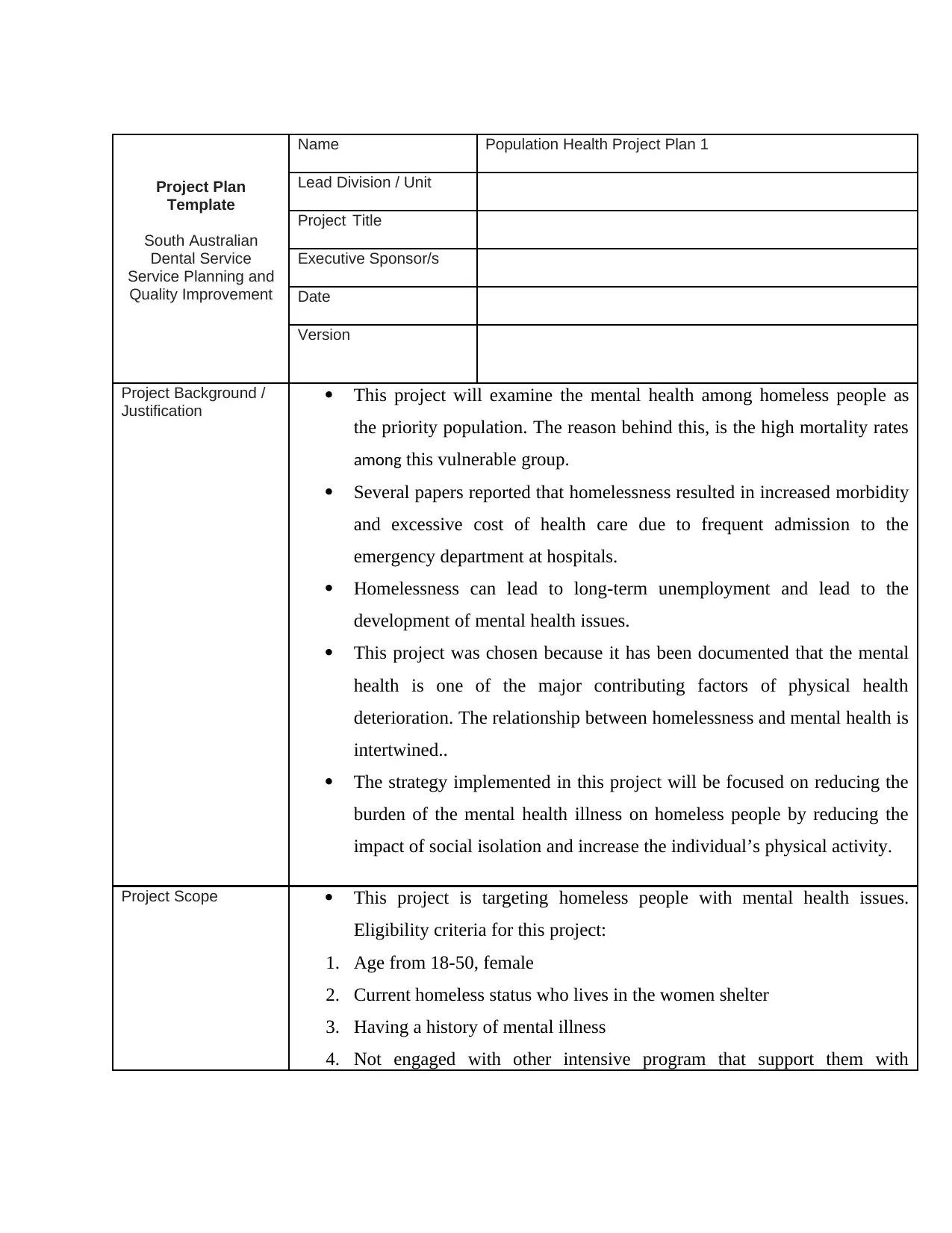
Project Plan
Template
South Australian
Dental Service
Service Planning and
Quality Improvement
Name Population Health Project Plan 1
Lead Division / Unit
Project Title
Executive Sponsor/s
Date
Version
Project Background /
Justification This project will examine the mental health among homeless people as
the priority population. The reason behind this, is the high mortality rates
among this vulnerable group.
Several papers reported that homelessness resulted in increased morbidity
and excessive cost of health care due to frequent admission to the
emergency department at hospitals.
Homelessness can lead to long-term unemployment and lead to the
development of mental health issues.
This project was chosen because it has been documented that the mental
health is one of the major contributing factors of physical health
deterioration. The relationship between homelessness and mental health is
intertwined..
The strategy implemented in this project will be focused on reducing the
burden of the mental health illness on homeless people by reducing the
impact of social isolation and increase the individual’s physical activity.
Project Scope This project is targeting homeless people with mental health issues.
Eligibility criteria for this project:
1. Age from 18-50, female
2. Current homeless status who lives in the women shelter
3. Having a history of mental illness
4. Not engaged with other intensive program that support them with
Template
South Australian
Dental Service
Service Planning and
Quality Improvement
Name Population Health Project Plan 1
Lead Division / Unit
Project Title
Executive Sponsor/s
Date
Version
Project Background /
Justification This project will examine the mental health among homeless people as
the priority population. The reason behind this, is the high mortality rates
among this vulnerable group.
Several papers reported that homelessness resulted in increased morbidity
and excessive cost of health care due to frequent admission to the
emergency department at hospitals.
Homelessness can lead to long-term unemployment and lead to the
development of mental health issues.
This project was chosen because it has been documented that the mental
health is one of the major contributing factors of physical health
deterioration. The relationship between homelessness and mental health is
intertwined..
The strategy implemented in this project will be focused on reducing the
burden of the mental health illness on homeless people by reducing the
impact of social isolation and increase the individual’s physical activity.
Project Scope This project is targeting homeless people with mental health issues.
Eligibility criteria for this project:
1. Age from 18-50, female
2. Current homeless status who lives in the women shelter
3. Having a history of mental illness
4. Not engaged with other intensive program that support them with
Secure Best Marks with AI Grader
Need help grading? Try our AI Grader for instant feedback on your assignments.
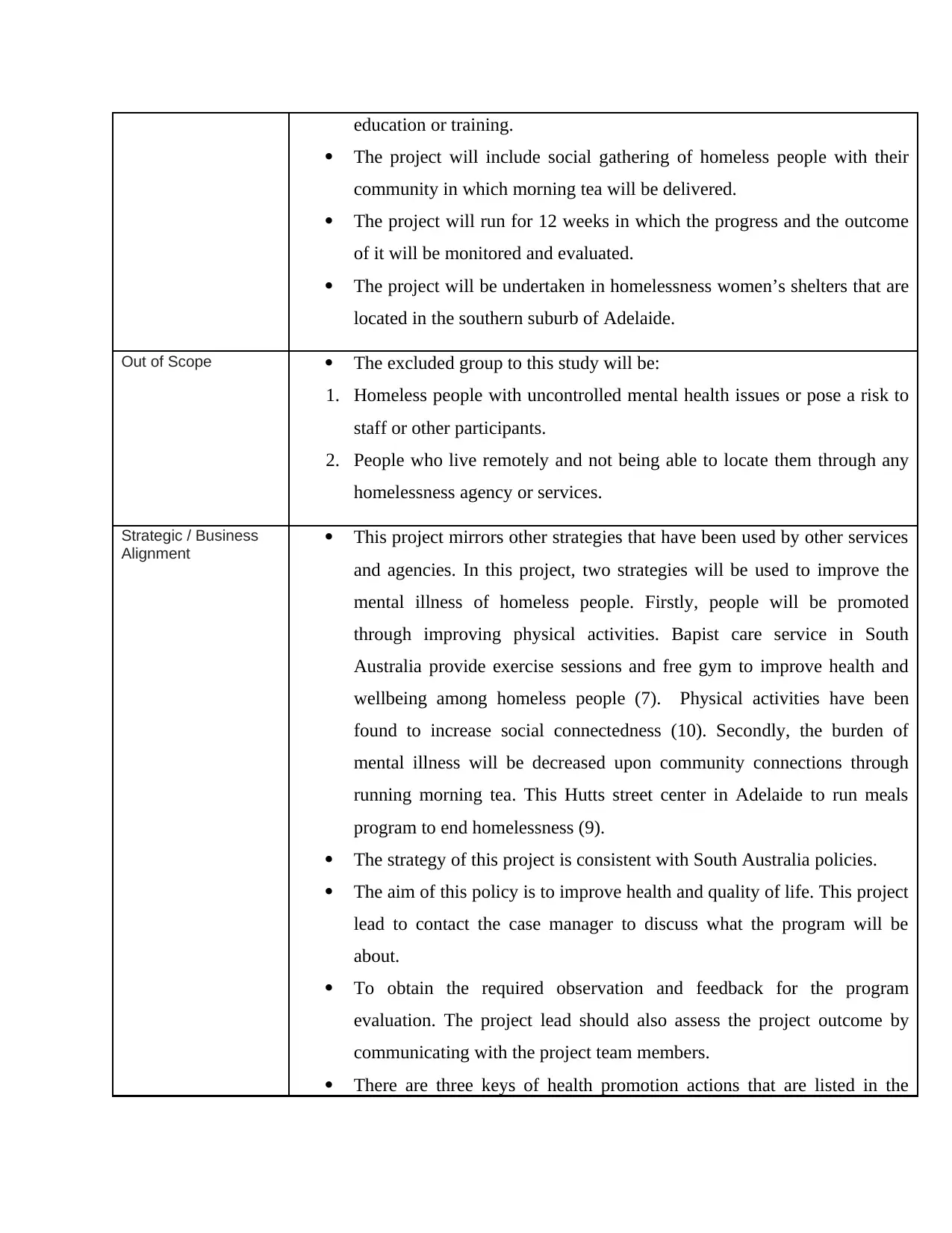
education or training.
The project will include social gathering of homeless people with their
community in which morning tea will be delivered.
The project will run for 12 weeks in which the progress and the outcome
of it will be monitored and evaluated.
The project will be undertaken in homelessness women’s shelters that are
located in the southern suburb of Adelaide.
Out of Scope The excluded group to this study will be:
1. Homeless people with uncontrolled mental health issues or pose a risk to
staff or other participants.
2. People who live remotely and not being able to locate them through any
homelessness agency or services.
Strategic / Business
Alignment This project mirrors other strategies that have been used by other services
and agencies. In this project, two strategies will be used to improve the
mental illness of homeless people. Firstly, people will be promoted
through improving physical activities. Bapist care service in South
Australia provide exercise sessions and free gym to improve health and
wellbeing among homeless people (7). Physical activities have been
found to increase social connectedness (10). Secondly, the burden of
mental illness will be decreased upon community connections through
running morning tea. This Hutts street center in Adelaide to run meals
program to end homelessness (9).
The strategy of this project is consistent with South Australia policies.
The aim of this policy is to improve health and quality of life. This project
lead to contact the case manager to discuss what the program will be
about.
To obtain the required observation and feedback for the program
evaluation. The project lead should also assess the project outcome by
communicating with the project team members.
There are three keys of health promotion actions that are listed in the
The project will include social gathering of homeless people with their
community in which morning tea will be delivered.
The project will run for 12 weeks in which the progress and the outcome
of it will be monitored and evaluated.
The project will be undertaken in homelessness women’s shelters that are
located in the southern suburb of Adelaide.
Out of Scope The excluded group to this study will be:
1. Homeless people with uncontrolled mental health issues or pose a risk to
staff or other participants.
2. People who live remotely and not being able to locate them through any
homelessness agency or services.
Strategic / Business
Alignment This project mirrors other strategies that have been used by other services
and agencies. In this project, two strategies will be used to improve the
mental illness of homeless people. Firstly, people will be promoted
through improving physical activities. Bapist care service in South
Australia provide exercise sessions and free gym to improve health and
wellbeing among homeless people (7). Physical activities have been
found to increase social connectedness (10). Secondly, the burden of
mental illness will be decreased upon community connections through
running morning tea. This Hutts street center in Adelaide to run meals
program to end homelessness (9).
The strategy of this project is consistent with South Australia policies.
The aim of this policy is to improve health and quality of life. This project
lead to contact the case manager to discuss what the program will be
about.
To obtain the required observation and feedback for the program
evaluation. The project lead should also assess the project outcome by
communicating with the project team members.
There are three keys of health promotion actions that are listed in the
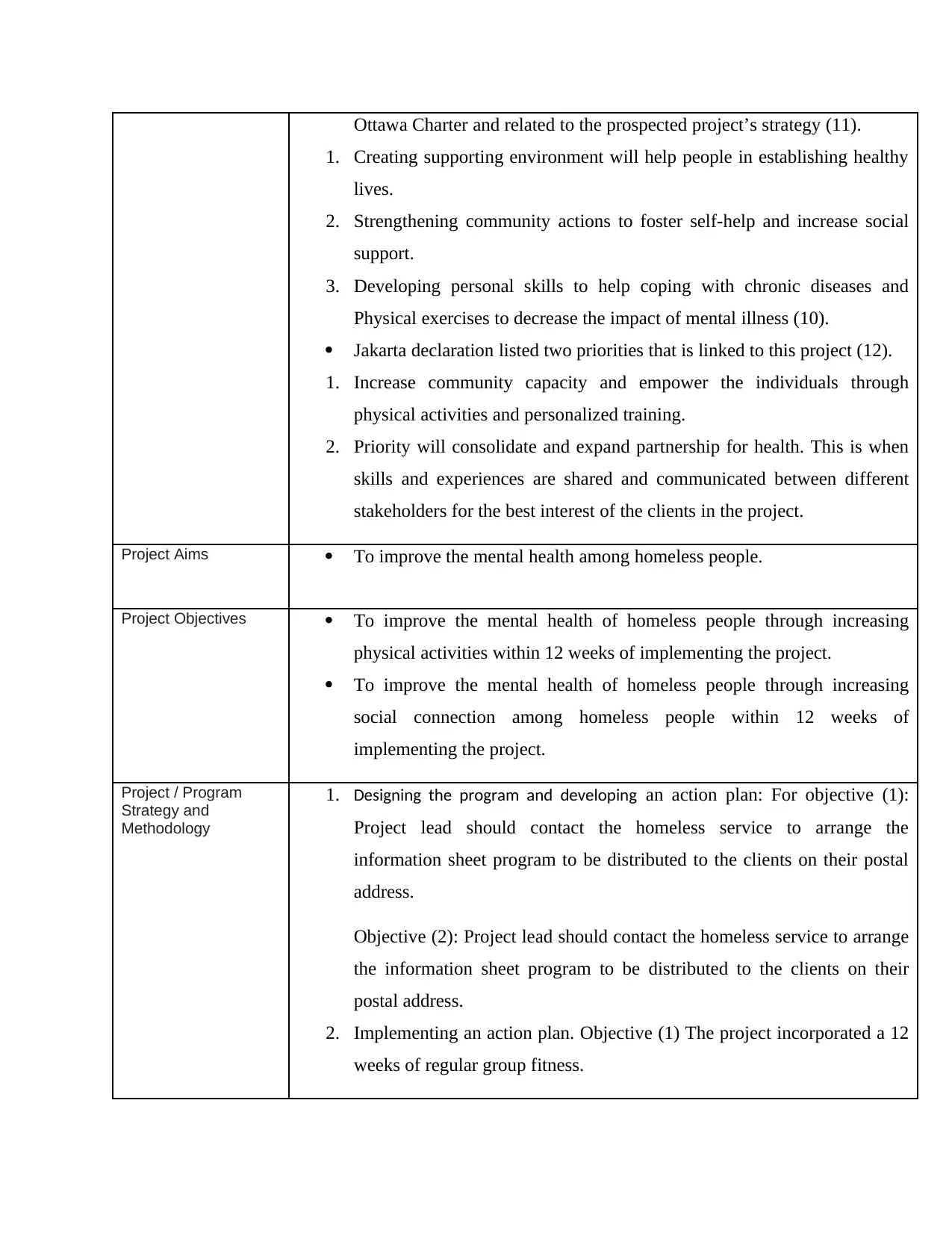
Ottawa Charter and related to the prospected project’s strategy (11).
1. Creating supporting environment will help people in establishing healthy
lives.
2. Strengthening community actions to foster self-help and increase social
support.
3. Developing personal skills to help coping with chronic diseases and
Physical exercises to decrease the impact of mental illness (10).
Jakarta declaration listed two priorities that is linked to this project (12).
1. Increase community capacity and empower the individuals through
physical activities and personalized training.
2. Priority will consolidate and expand partnership for health. This is when
skills and experiences are shared and communicated between different
stakeholders for the best interest of the clients in the project.
Project Aims To improve the mental health among homeless people.
Project Objectives To improve the mental health of homeless people through increasing
physical activities within 12 weeks of implementing the project.
To improve the mental health of homeless people through increasing
social connection among homeless people within 12 weeks of
implementing the project.
Project / Program
Strategy and
Methodology
1. Designing the program and developing an action plan: For objective (1):
Project lead should contact the homeless service to arrange the
information sheet program to be distributed to the clients on their postal
address.
Objective (2): Project lead should contact the homeless service to arrange
the information sheet program to be distributed to the clients on their
postal address.
2. Implementing an action plan. Objective (1) The project incorporated a 12
weeks of regular group fitness.
1. Creating supporting environment will help people in establishing healthy
lives.
2. Strengthening community actions to foster self-help and increase social
support.
3. Developing personal skills to help coping with chronic diseases and
Physical exercises to decrease the impact of mental illness (10).
Jakarta declaration listed two priorities that is linked to this project (12).
1. Increase community capacity and empower the individuals through
physical activities and personalized training.
2. Priority will consolidate and expand partnership for health. This is when
skills and experiences are shared and communicated between different
stakeholders for the best interest of the clients in the project.
Project Aims To improve the mental health among homeless people.
Project Objectives To improve the mental health of homeless people through increasing
physical activities within 12 weeks of implementing the project.
To improve the mental health of homeless people through increasing
social connection among homeless people within 12 weeks of
implementing the project.
Project / Program
Strategy and
Methodology
1. Designing the program and developing an action plan: For objective (1):
Project lead should contact the homeless service to arrange the
information sheet program to be distributed to the clients on their postal
address.
Objective (2): Project lead should contact the homeless service to arrange
the information sheet program to be distributed to the clients on their
postal address.
2. Implementing an action plan. Objective (1) The project incorporated a 12
weeks of regular group fitness.
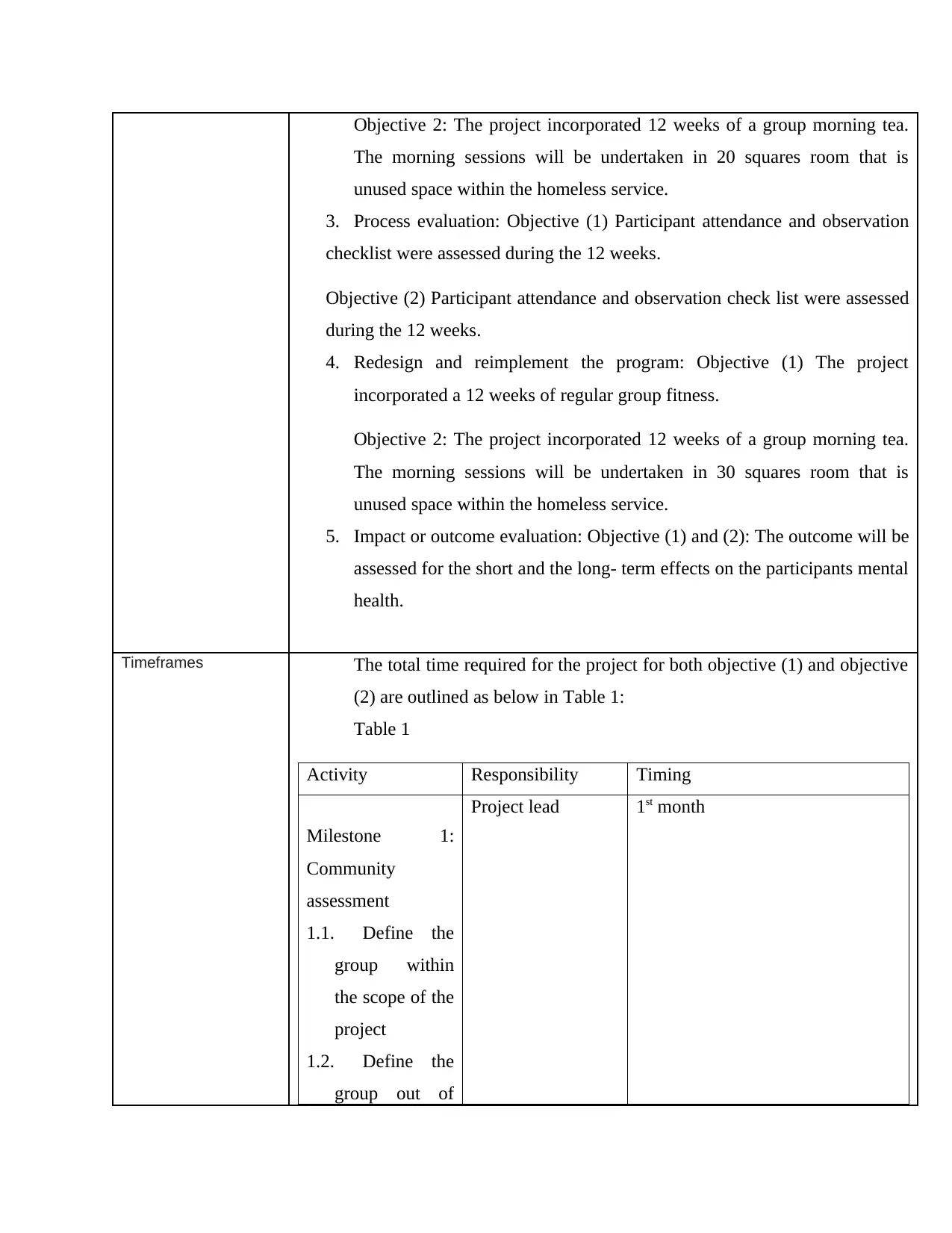
Objective 2: The project incorporated 12 weeks of a group morning tea.
The morning sessions will be undertaken in 20 squares room that is
unused space within the homeless service.
3. Process evaluation: Objective (1) Participant attendance and observation
checklist were assessed during the 12 weeks.
Objective (2) Participant attendance and observation check list were assessed
during the 12 weeks.
4. Redesign and reimplement the program: Objective (1) The project
incorporated a 12 weeks of regular group fitness.
Objective 2: The project incorporated 12 weeks of a group morning tea.
The morning sessions will be undertaken in 30 squares room that is
unused space within the homeless service.
5. Impact or outcome evaluation: Objective (1) and (2): The outcome will be
assessed for the short and the long- term effects on the participants mental
health.
Timeframes The total time required for the project for both objective (1) and objective
(2) are outlined as below in Table 1:
Table 1
Activity Responsibility Timing
Milestone 1:
Community
assessment
1.1. Define the
group within
the scope of the
project
1.2. Define the
group out of
Project lead 1st month
The morning sessions will be undertaken in 20 squares room that is
unused space within the homeless service.
3. Process evaluation: Objective (1) Participant attendance and observation
checklist were assessed during the 12 weeks.
Objective (2) Participant attendance and observation check list were assessed
during the 12 weeks.
4. Redesign and reimplement the program: Objective (1) The project
incorporated a 12 weeks of regular group fitness.
Objective 2: The project incorporated 12 weeks of a group morning tea.
The morning sessions will be undertaken in 30 squares room that is
unused space within the homeless service.
5. Impact or outcome evaluation: Objective (1) and (2): The outcome will be
assessed for the short and the long- term effects on the participants mental
health.
Timeframes The total time required for the project for both objective (1) and objective
(2) are outlined as below in Table 1:
Table 1
Activity Responsibility Timing
Milestone 1:
Community
assessment
1.1. Define the
group within
the scope of the
project
1.2. Define the
group out of
Project lead 1st month
Secure Best Marks with AI Grader
Need help grading? Try our AI Grader for instant feedback on your assignments.
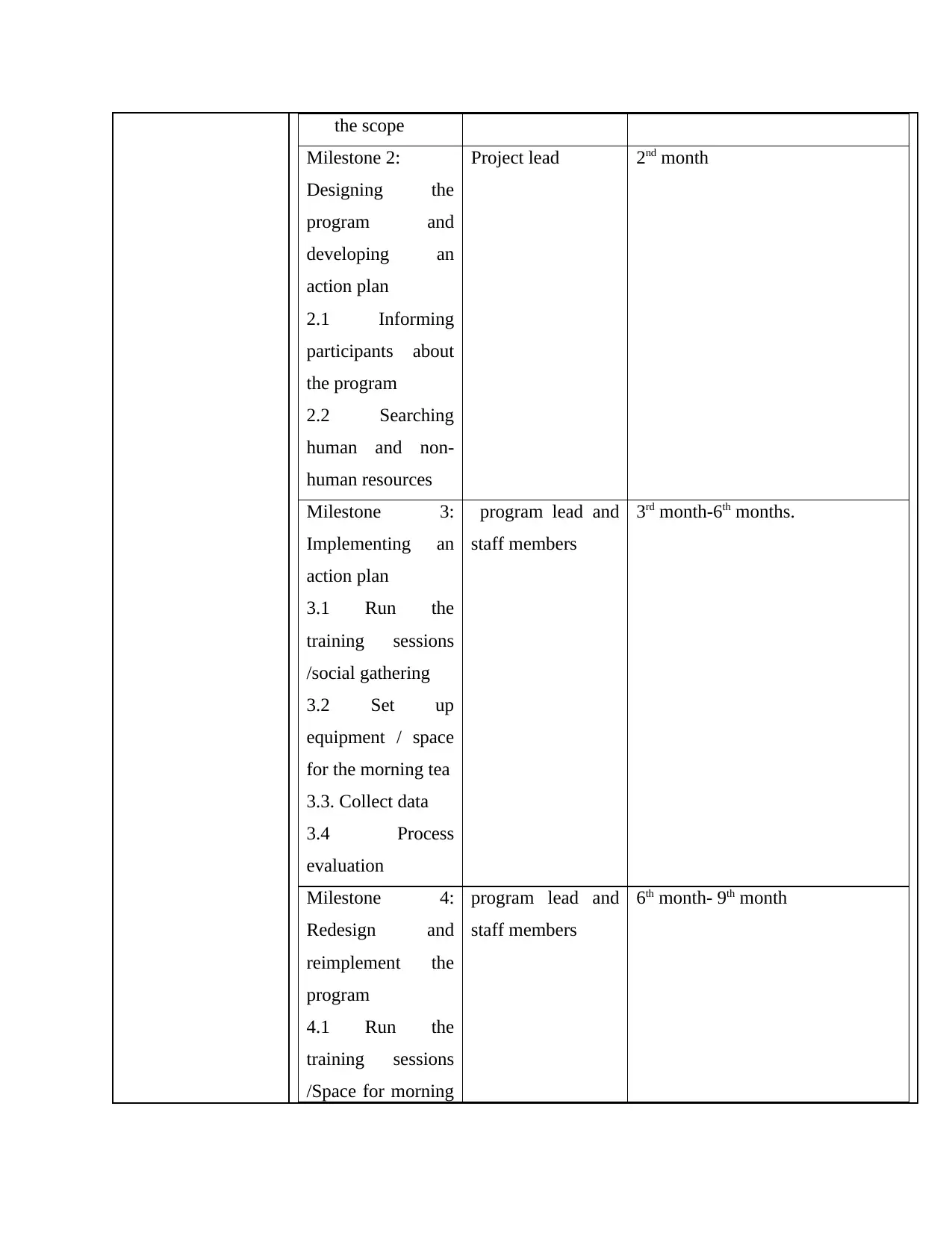
the scope
Milestone 2:
Designing the
program and
developing an
action plan
2.1 Informing
participants about
the program
2.2 Searching
human and non-
human resources
Project lead 2nd month
Milestone 3:
Implementing an
action plan
3.1 Run the
training sessions
/social gathering
3.2 Set up
equipment / space
for the morning tea
3.3. Collect data
3.4 Process
evaluation
program lead and
staff members
3rd month-6th months.
Milestone 4:
Redesign and
reimplement the
program
4.1 Run the
training sessions
/Space for morning
program lead and
staff members
6th month- 9th month
Milestone 2:
Designing the
program and
developing an
action plan
2.1 Informing
participants about
the program
2.2 Searching
human and non-
human resources
Project lead 2nd month
Milestone 3:
Implementing an
action plan
3.1 Run the
training sessions
/social gathering
3.2 Set up
equipment / space
for the morning tea
3.3. Collect data
3.4 Process
evaluation
program lead and
staff members
3rd month-6th months.
Milestone 4:
Redesign and
reimplement the
program
4.1 Run the
training sessions
/Space for morning
program lead and
staff members
6th month- 9th month
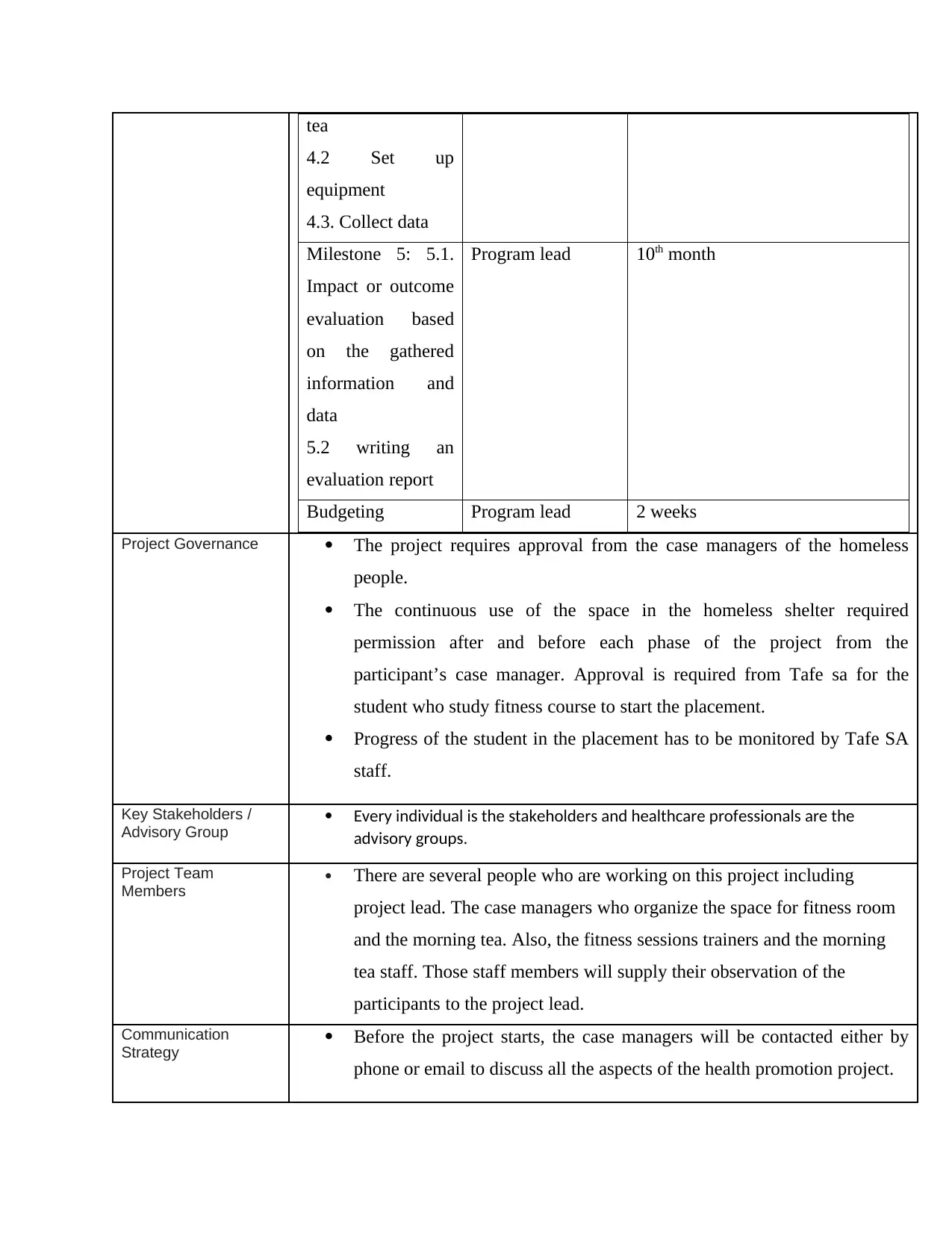
tea
4.2 Set up
equipment
4.3. Collect data
Milestone 5: 5.1.
Impact or outcome
evaluation based
on the gathered
information and
data
5.2 writing an
evaluation report
Program lead 10th month
Budgeting Program lead 2 weeks
Project Governance The project requires approval from the case managers of the homeless
people.
The continuous use of the space in the homeless shelter required
permission after and before each phase of the project from the
participant’s case manager. Approval is required from Tafe sa for the
student who study fitness course to start the placement.
Progress of the student in the placement has to be monitored by Tafe SA
staff.
Key Stakeholders /
Advisory Group
Every individual is the stakeholders and healthcare professionals are the
advisory groups.
Project Team
Members There are several people who are working on this project including
project lead. The case managers who organize the space for fitness room
and the morning tea. Also, the fitness sessions trainers and the morning
tea staff. Those staff members will supply their observation of the
participants to the project lead.
Communication
Strategy Before the project starts, the case managers will be contacted either by
phone or email to discuss all the aspects of the health promotion project.
4.2 Set up
equipment
4.3. Collect data
Milestone 5: 5.1.
Impact or outcome
evaluation based
on the gathered
information and
data
5.2 writing an
evaluation report
Program lead 10th month
Budgeting Program lead 2 weeks
Project Governance The project requires approval from the case managers of the homeless
people.
The continuous use of the space in the homeless shelter required
permission after and before each phase of the project from the
participant’s case manager. Approval is required from Tafe sa for the
student who study fitness course to start the placement.
Progress of the student in the placement has to be monitored by Tafe SA
staff.
Key Stakeholders /
Advisory Group
Every individual is the stakeholders and healthcare professionals are the
advisory groups.
Project Team
Members There are several people who are working on this project including
project lead. The case managers who organize the space for fitness room
and the morning tea. Also, the fitness sessions trainers and the morning
tea staff. Those staff members will supply their observation of the
participants to the project lead.
Communication
Strategy Before the project starts, the case managers will be contacted either by
phone or email to discuss all the aspects of the health promotion project.
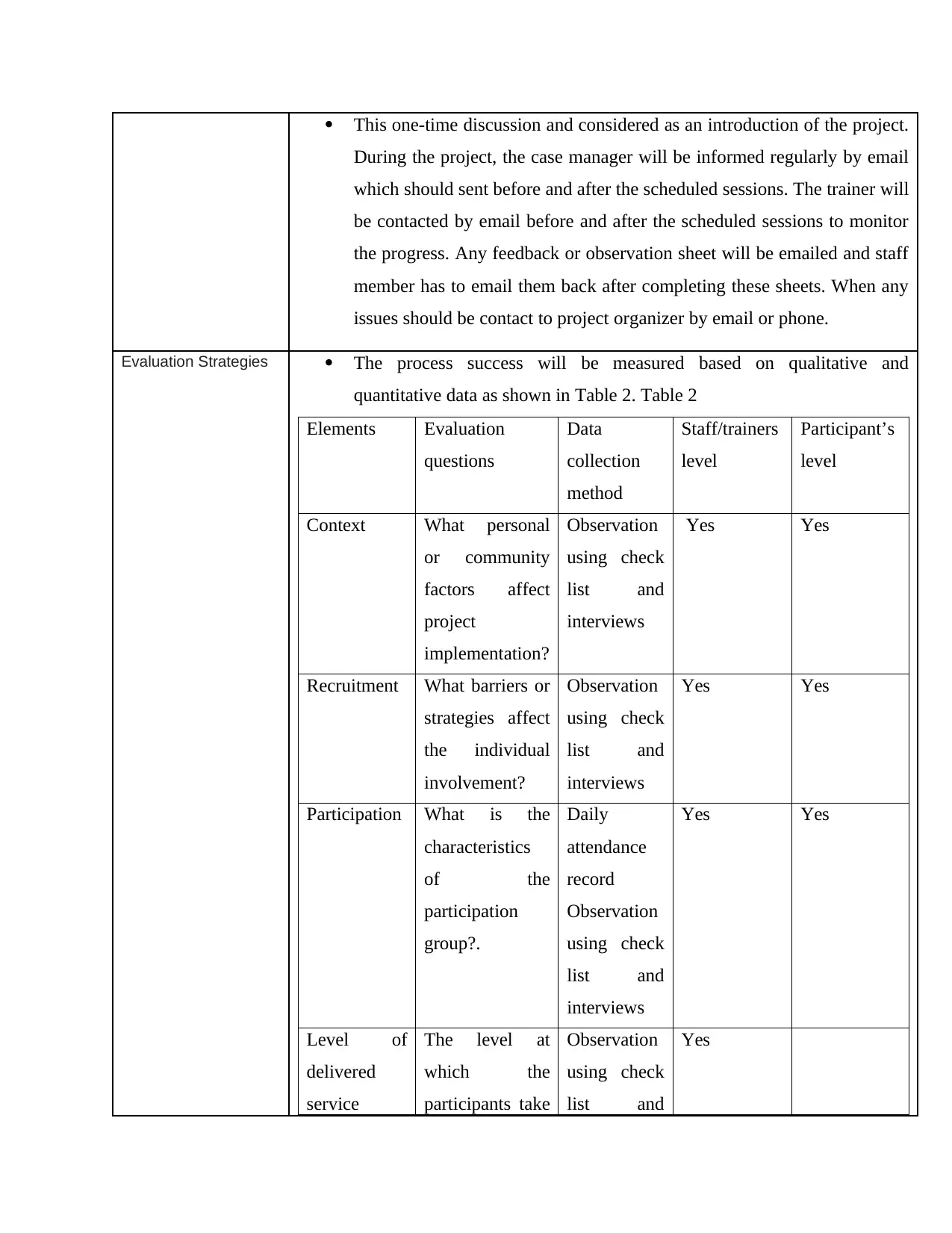
This one-time discussion and considered as an introduction of the project.
During the project, the case manager will be informed regularly by email
which should sent before and after the scheduled sessions. The trainer will
be contacted by email before and after the scheduled sessions to monitor
the progress. Any feedback or observation sheet will be emailed and staff
member has to email them back after completing these sheets. When any
issues should be contact to project organizer by email or phone.
Evaluation Strategies The process success will be measured based on qualitative and
quantitative data as shown in Table 2. Table 2
Elements Evaluation
questions
Data
collection
method
Staff/trainers
level
Participant’s
level
Context What personal
or community
factors affect
project
implementation?
Observation
using check
list and
interviews
Yes Yes
Recruitment What barriers or
strategies affect
the individual
involvement?
Observation
using check
list and
interviews
Yes Yes
Participation What is the
characteristics
of the
participation
group?.
Daily
attendance
record
Observation
using check
list and
interviews
Yes Yes
Level of
delivered
service
The level at
which the
participants take
Observation
using check
list and
Yes
During the project, the case manager will be informed regularly by email
which should sent before and after the scheduled sessions. The trainer will
be contacted by email before and after the scheduled sessions to monitor
the progress. Any feedback or observation sheet will be emailed and staff
member has to email them back after completing these sheets. When any
issues should be contact to project organizer by email or phone.
Evaluation Strategies The process success will be measured based on qualitative and
quantitative data as shown in Table 2. Table 2
Elements Evaluation
questions
Data
collection
method
Staff/trainers
level
Participant’s
level
Context What personal
or community
factors affect
project
implementation?
Observation
using check
list and
interviews
Yes Yes
Recruitment What barriers or
strategies affect
the individual
involvement?
Observation
using check
list and
interviews
Yes Yes
Participation What is the
characteristics
of the
participation
group?.
Daily
attendance
record
Observation
using check
list and
interviews
Yes Yes
Level of
delivered
service
The level at
which the
participants take
Observation
using check
list and
Yes
Paraphrase This Document
Need a fresh take? Get an instant paraphrase of this document with our AI Paraphraser
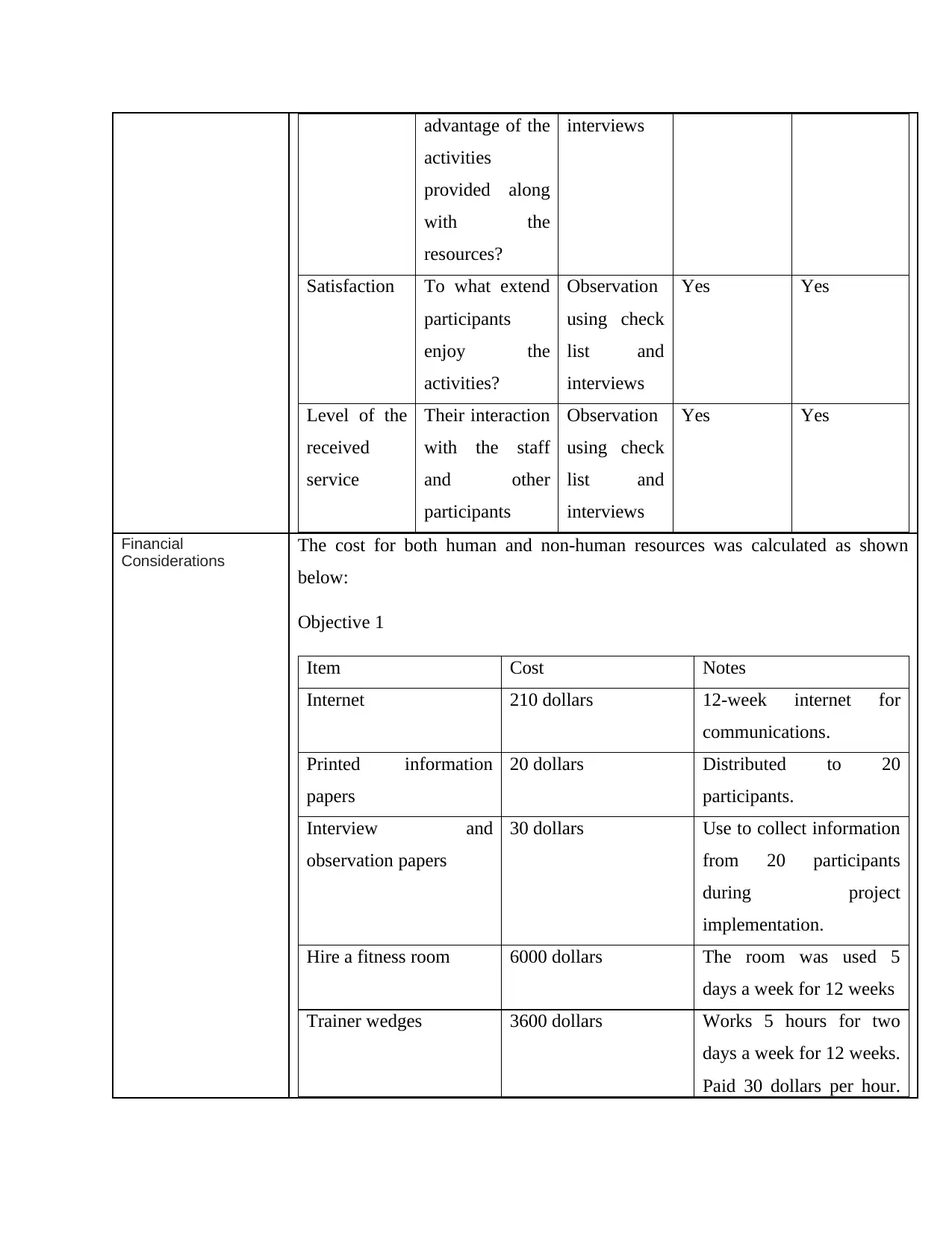
advantage of the
activities
provided along
with the
resources?
interviews
Satisfaction To what extend
participants
enjoy the
activities?
Observation
using check
list and
interviews
Yes Yes
Level of the
received
service
Their interaction
with the staff
and other
participants
Observation
using check
list and
interviews
Yes Yes
Financial
Considerations The cost for both human and non-human resources was calculated as shown
below:
Objective 1
Item Cost Notes
Internet 210 dollars 12-week internet for
communications.
Printed information
papers
20 dollars Distributed to 20
participants.
Interview and
observation papers
30 dollars Use to collect information
from 20 participants
during project
implementation.
Hire a fitness room 6000 dollars The room was used 5
days a week for 12 weeks
Trainer wedges 3600 dollars Works 5 hours for two
days a week for 12 weeks.
Paid 30 dollars per hour.
activities
provided along
with the
resources?
interviews
Satisfaction To what extend
participants
enjoy the
activities?
Observation
using check
list and
interviews
Yes Yes
Level of the
received
service
Their interaction
with the staff
and other
participants
Observation
using check
list and
interviews
Yes Yes
Financial
Considerations The cost for both human and non-human resources was calculated as shown
below:
Objective 1
Item Cost Notes
Internet 210 dollars 12-week internet for
communications.
Printed information
papers
20 dollars Distributed to 20
participants.
Interview and
observation papers
30 dollars Use to collect information
from 20 participants
during project
implementation.
Hire a fitness room 6000 dollars The room was used 5
days a week for 12 weeks
Trainer wedges 3600 dollars Works 5 hours for two
days a week for 12 weeks.
Paid 30 dollars per hour.
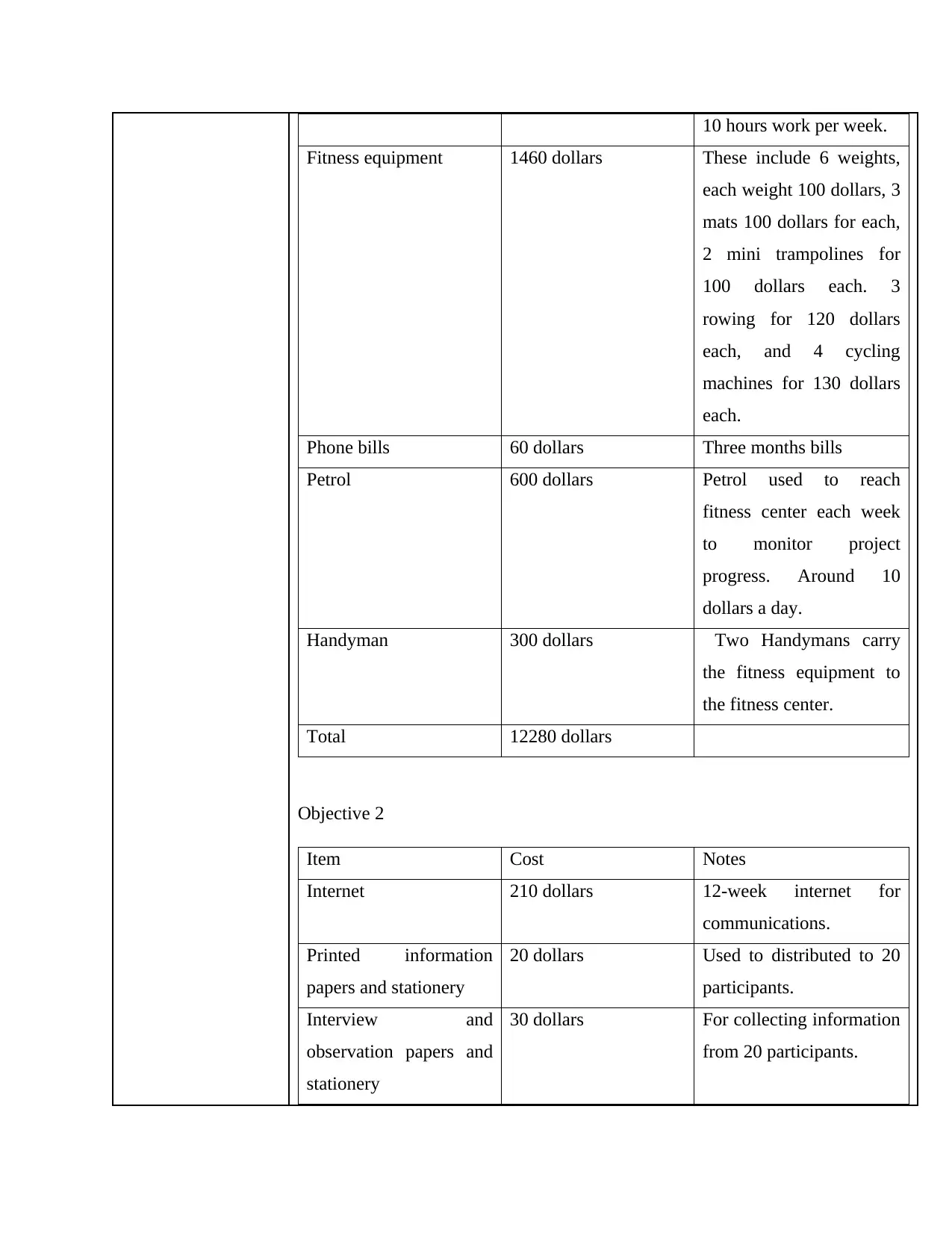
10 hours work per week.
Fitness equipment 1460 dollars These include 6 weights,
each weight 100 dollars, 3
mats 100 dollars for each,
2 mini trampolines for
100 dollars each. 3
rowing for 120 dollars
each, and 4 cycling
machines for 130 dollars
each.
Phone bills 60 dollars Three months bills
Petrol 600 dollars Petrol used to reach
fitness center each week
to monitor project
progress. Around 10
dollars a day.
Handyman 300 dollars Two Handymans carry
the fitness equipment to
the fitness center.
Total 12280 dollars
Objective 2
Item Cost Notes
Internet 210 dollars 12-week internet for
communications.
Printed information
papers and stationery
20 dollars Used to distributed to 20
participants.
Interview and
observation papers and
stationery
30 dollars For collecting information
from 20 participants.
Fitness equipment 1460 dollars These include 6 weights,
each weight 100 dollars, 3
mats 100 dollars for each,
2 mini trampolines for
100 dollars each. 3
rowing for 120 dollars
each, and 4 cycling
machines for 130 dollars
each.
Phone bills 60 dollars Three months bills
Petrol 600 dollars Petrol used to reach
fitness center each week
to monitor project
progress. Around 10
dollars a day.
Handyman 300 dollars Two Handymans carry
the fitness equipment to
the fitness center.
Total 12280 dollars
Objective 2
Item Cost Notes
Internet 210 dollars 12-week internet for
communications.
Printed information
papers and stationery
20 dollars Used to distributed to 20
participants.
Interview and
observation papers and
stationery
30 dollars For collecting information
from 20 participants.
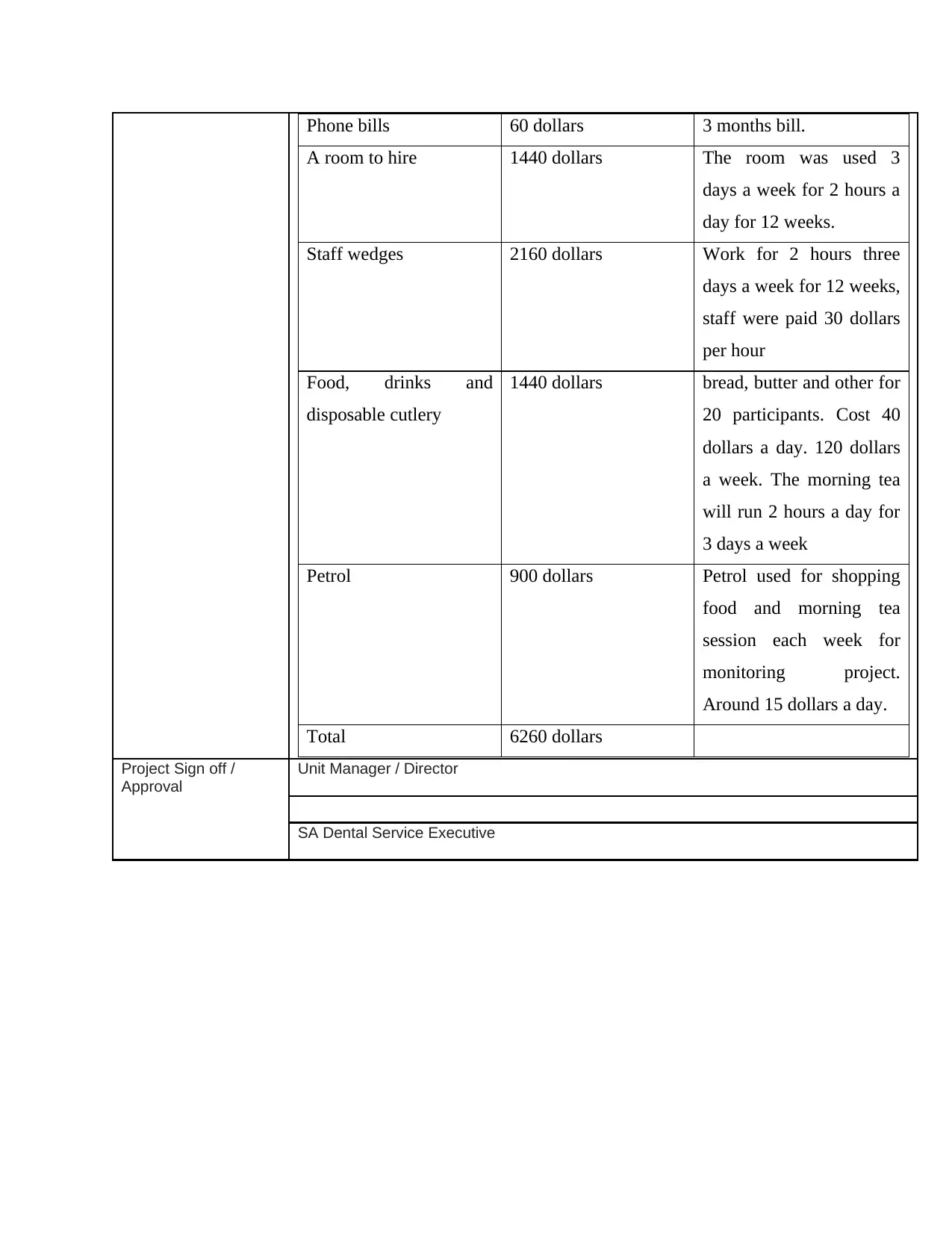
Phone bills 60 dollars 3 months bill.
A room to hire 1440 dollars The room was used 3
days a week for 2 hours a
day for 12 weeks.
Staff wedges 2160 dollars Work for 2 hours three
days a week for 12 weeks,
staff were paid 30 dollars
per hour
Food, drinks and
disposable cutlery
1440 dollars bread, butter and other for
20 participants. Cost 40
dollars a day. 120 dollars
a week. The morning tea
will run 2 hours a day for
3 days a week
Petrol 900 dollars Petrol used for shopping
food and morning tea
session each week for
monitoring project.
Around 15 dollars a day.
Total 6260 dollars
Project Sign off /
Approval
Unit Manager / Director
SA Dental Service Executive
A room to hire 1440 dollars The room was used 3
days a week for 2 hours a
day for 12 weeks.
Staff wedges 2160 dollars Work for 2 hours three
days a week for 12 weeks,
staff were paid 30 dollars
per hour
Food, drinks and
disposable cutlery
1440 dollars bread, butter and other for
20 participants. Cost 40
dollars a day. 120 dollars
a week. The morning tea
will run 2 hours a day for
3 days a week
Petrol 900 dollars Petrol used for shopping
food and morning tea
session each week for
monitoring project.
Around 15 dollars a day.
Total 6260 dollars
Project Sign off /
Approval
Unit Manager / Director
SA Dental Service Executive
Secure Best Marks with AI Grader
Need help grading? Try our AI Grader for instant feedback on your assignments.
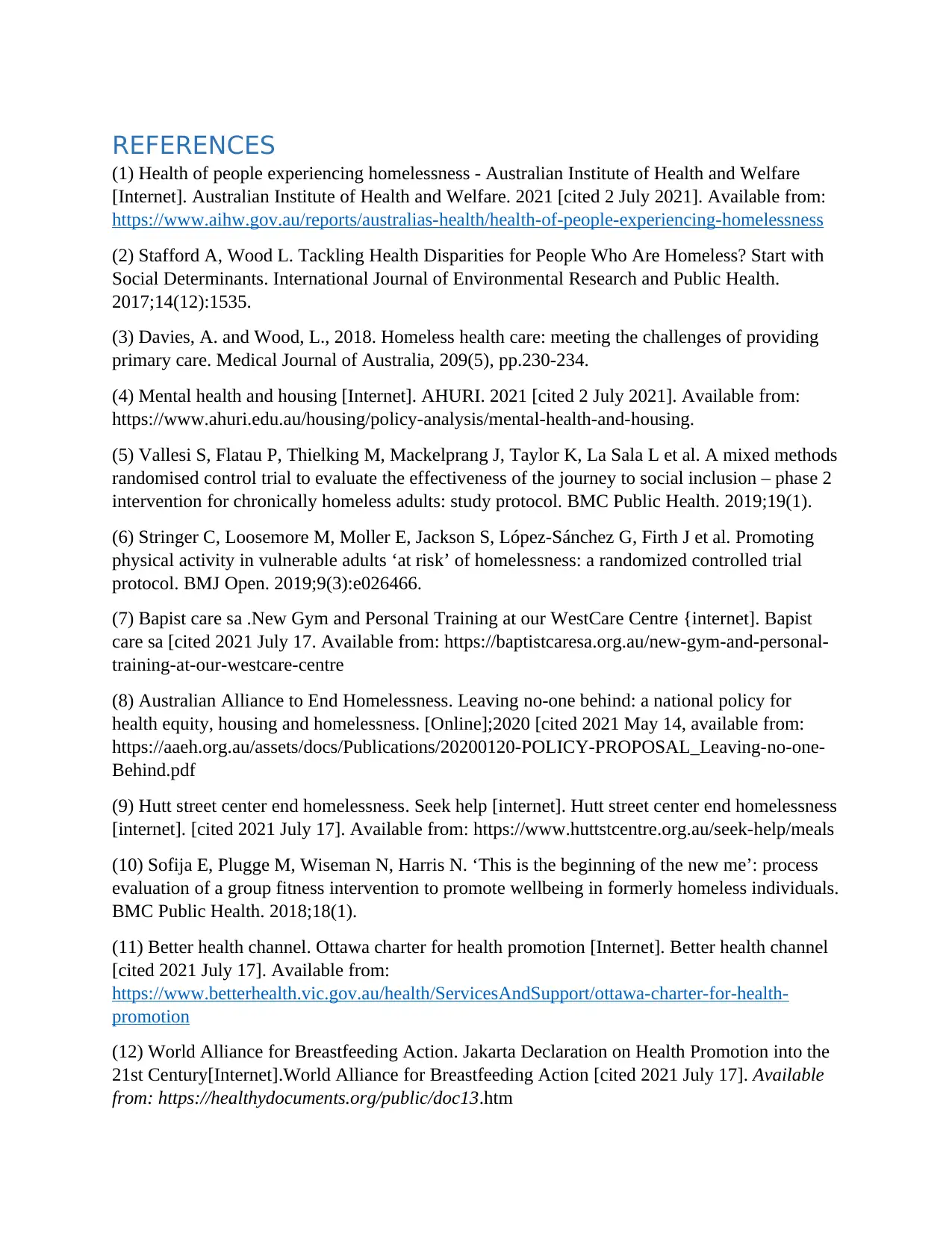
REFERENCES
(1) Health of people experiencing homelessness - Australian Institute of Health and Welfare
[Internet]. Australian Institute of Health and Welfare. 2021 [cited 2 July 2021]. Available from:
https://www.aihw.gov.au/reports/australias-health/health-of-people-experiencing-homelessness
(2) Stafford A, Wood L. Tackling Health Disparities for People Who Are Homeless? Start with
Social Determinants. International Journal of Environmental Research and Public Health.
2017;14(12):1535.
(3) Davies, A. and Wood, L., 2018. Homeless health care: meeting the challenges of providing
primary care. Medical Journal of Australia, 209(5), pp.230-234.
(4) Mental health and housing [Internet]. AHURI. 2021 [cited 2 July 2021]. Available from:
https://www.ahuri.edu.au/housing/policy-analysis/mental-health-and-housing.
(5) Vallesi S, Flatau P, Thielking M, Mackelprang J, Taylor K, La Sala L et al. A mixed methods
randomised control trial to evaluate the effectiveness of the journey to social inclusion – phase 2
intervention for chronically homeless adults: study protocol. BMC Public Health. 2019;19(1).
(6) Stringer C, Loosemore M, Moller E, Jackson S, López-Sánchez G, Firth J et al. Promoting
physical activity in vulnerable adults ‘at risk’ of homelessness: a randomized controlled trial
protocol. BMJ Open. 2019;9(3):e026466.
(7) Bapist care sa .New Gym and Personal Training at our WestCare Centre {internet]. Bapist
care sa [cited 2021 July 17. Available from: https://baptistcaresa.org.au/new-gym-and-personal-
training-at-our-westcare-centre
(8) Australian Alliance to End Homelessness. Leaving no-one behind: a national policy for
health equity, housing and homelessness. [Online];2020 [cited 2021 May 14, available from:
https://aaeh.org.au/assets/docs/Publications/20200120-POLICY-PROPOSAL_Leaving-no-one-
Behind.pdf
(9) Hutt street center end homelessness. Seek help [internet]. Hutt street center end homelessness
[internet]. [cited 2021 July 17]. Available from: https://www.huttstcentre.org.au/seek-help/meals
(10) Sofija E, Plugge M, Wiseman N, Harris N. ‘This is the beginning of the new me’: process
evaluation of a group fitness intervention to promote wellbeing in formerly homeless individuals.
BMC Public Health. 2018;18(1).
(11) Better health channel. Ottawa charter for health promotion [Internet]. Better health channel
[cited 2021 July 17]. Available from:
https://www.betterhealth.vic.gov.au/health/ServicesAndSupport/ottawa-charter-for-health-
promotion
(12) World Alliance for Breastfeeding Action. Jakarta Declaration on Health Promotion into the
21st Century[Internet].World Alliance for Breastfeeding Action [cited 2021 July 17]. Available
from: https://healthydocuments.org/public/doc13.htm
(1) Health of people experiencing homelessness - Australian Institute of Health and Welfare
[Internet]. Australian Institute of Health and Welfare. 2021 [cited 2 July 2021]. Available from:
https://www.aihw.gov.au/reports/australias-health/health-of-people-experiencing-homelessness
(2) Stafford A, Wood L. Tackling Health Disparities for People Who Are Homeless? Start with
Social Determinants. International Journal of Environmental Research and Public Health.
2017;14(12):1535.
(3) Davies, A. and Wood, L., 2018. Homeless health care: meeting the challenges of providing
primary care. Medical Journal of Australia, 209(5), pp.230-234.
(4) Mental health and housing [Internet]. AHURI. 2021 [cited 2 July 2021]. Available from:
https://www.ahuri.edu.au/housing/policy-analysis/mental-health-and-housing.
(5) Vallesi S, Flatau P, Thielking M, Mackelprang J, Taylor K, La Sala L et al. A mixed methods
randomised control trial to evaluate the effectiveness of the journey to social inclusion – phase 2
intervention for chronically homeless adults: study protocol. BMC Public Health. 2019;19(1).
(6) Stringer C, Loosemore M, Moller E, Jackson S, López-Sánchez G, Firth J et al. Promoting
physical activity in vulnerable adults ‘at risk’ of homelessness: a randomized controlled trial
protocol. BMJ Open. 2019;9(3):e026466.
(7) Bapist care sa .New Gym and Personal Training at our WestCare Centre {internet]. Bapist
care sa [cited 2021 July 17. Available from: https://baptistcaresa.org.au/new-gym-and-personal-
training-at-our-westcare-centre
(8) Australian Alliance to End Homelessness. Leaving no-one behind: a national policy for
health equity, housing and homelessness. [Online];2020 [cited 2021 May 14, available from:
https://aaeh.org.au/assets/docs/Publications/20200120-POLICY-PROPOSAL_Leaving-no-one-
Behind.pdf
(9) Hutt street center end homelessness. Seek help [internet]. Hutt street center end homelessness
[internet]. [cited 2021 July 17]. Available from: https://www.huttstcentre.org.au/seek-help/meals
(10) Sofija E, Plugge M, Wiseman N, Harris N. ‘This is the beginning of the new me’: process
evaluation of a group fitness intervention to promote wellbeing in formerly homeless individuals.
BMC Public Health. 2018;18(1).
(11) Better health channel. Ottawa charter for health promotion [Internet]. Better health channel
[cited 2021 July 17]. Available from:
https://www.betterhealth.vic.gov.au/health/ServicesAndSupport/ottawa-charter-for-health-
promotion
(12) World Alliance for Breastfeeding Action. Jakarta Declaration on Health Promotion into the
21st Century[Internet].World Alliance for Breastfeeding Action [cited 2021 July 17]. Available
from: https://healthydocuments.org/public/doc13.htm
1 out of 11
Related Documents
Your All-in-One AI-Powered Toolkit for Academic Success.
+13062052269
info@desklib.com
Available 24*7 on WhatsApp / Email
![[object Object]](/_next/static/media/star-bottom.7253800d.svg)
Unlock your academic potential
© 2024 | Zucol Services PVT LTD | All rights reserved.




